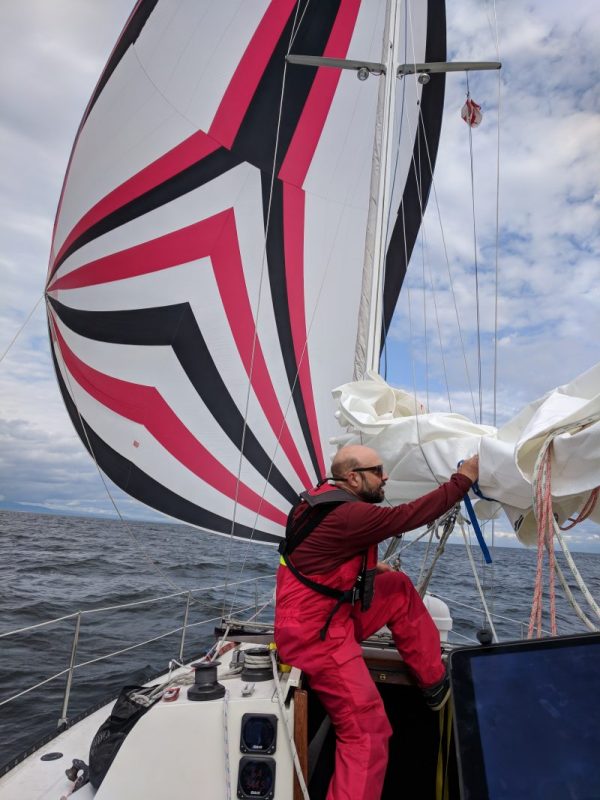Update: The satellite tracker is working now: Check our live position: https://forecast.predictwind.com/tracking/display/Sage
Usually the prevailing winds in the Pacific NW in spring are from the North. We got lucky however that the day we were planning to leave Vancouver a strong S/SE wind was forecasted. We were planning to take advantage of it and left Coal Harbor in downtown Vancouver at 8am, motored around the Stanley Park peninsula and after slipping through First Narrows raised full sails in Burrard Inlet. The wind started picking up and we reduced sail to the foresail only while we surfed down 6ft waves.
By afternoon we caught sight of Jedidiah Island, our anchorage for the night. Approaching the narrow channel of Bull Passage from the wind whipped, white crested waves of Georgia Strait was quite the spectacle but after turning the corner behind the Island the sea and wind calmed down significantly. Surprisingly quite a few sailboats were hiding out from the wind here and the standard chart book anchorages were fairly crowded. So we opted for the small Otter Cove where we set a stern tie to prevent swinging around on the anchor and hitting the rocks. This method of anchoring is fairly common in these water due to the steep shoreline that drops off rapidly under water.
After a quiet night we weighed anchor at 8am, retrieved our shore tie and set back out into the Strait of Georgia for another day of high wind, downwind sailing. The winds proved less severe and around noon we decided to raise the spinnaker to maintain high speed since we had a long way to go to Campbell River. By afternoon we were approaching Discovery Passage, a narrow channel with wild currents through which twice daily the tides push immense amounts of water in and out of Georgia Strait. Campbell River is at the entrance of Discovery Passage and was going to be our staging ground to transit Seymour Narrows, the narrowest point of the passage. Due to the high currents, Seymour Narrows can only be transited at slack water (i.e. when the tides turn from flood to ebb or vice versa). All commercial traffic including cruise ships have to go through here. We lowered sail on entrance to Discovery Passage to motor into the port but noticed a squealing sound coming from the engine. Limping into port and tying up to a transient dock with the fishing fleet we diagnosed the problem as a worn out bearing on the freshwater engine cooling pump. It was too late to go into town to see if they would have spare parts so we ate dinner and called it a day.
First thing in the morning we called the two Yanmar dealers in town. One of them, Altech, had the freshwater pump in stock. We took a taxi to go get it and had it installed before breakfast. Since it was too late to depart for Seymour Narrows we spent a couple more hours to also replace the leaky diesel lift pump. Now it is all buttoned up and ready to go for a noon departure through Seymour Narrows tomorrow. We are then going to ride the ebb current for the remaining 6 hours and find an anchorage somewhere in Johnstone Strait.
